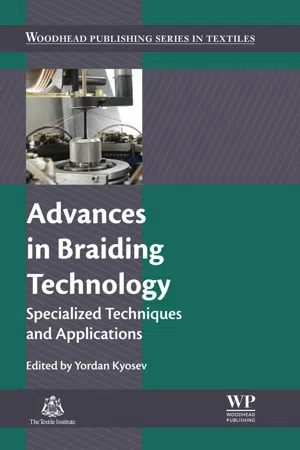
Advances in Braiding Technology
Specialized Techniques and Applications
Yordan Kyosev
- 608 páginas
- English
- ePUB (apto para móviles)
- Disponible en iOS y Android
Advances in Braiding Technology
Specialized Techniques and Applications
Yordan Kyosev
Información del libro
Braiding is the process of interlacing three or more threads or yarns in a diagonal direction to the product axis in order to obtain thicker, wider or stronger textiles or, in the case of overbraiding, in order to cover a profile. Braids are becoming the reinforcement of choice in composite manufacturing, and have found a range of technical applications in fields including medicine, candles, transport and aerospace. Building on the information provided in Prof. Kyosev's previous book, Braiding Technology for Textiles, this important title covers advanced technologies and new developments for the manufacture, applications and modelling of braided products.
Part One covers the braiding of three-dimensional profiles, and includes a detailed overview of three-dimensional braiding technologies as well as chapters devoted to specific kinds of 3D braiding. Part Two addresses specialist braiding techniques and applications, and includes chapters reviewing the use of braids for medical textiles and candles. Part Three focuses on braiding techniques for ropes and Part Four reviews braiding for composites. The final part of the book considers modelling and simulation, and covers topics including overbraiding simulation, Finite Element Method (FEM) modelling and geometrical modelling.
- Covers advanced braiding techniques, technical applications, and modelling and simulation of braided textiles.
- Focused on the needs of the textile industry by offering suitable breadth and depth of coverage of a range of braiding manufacturing technology, applications and modelling techniques in a single volume.
- Written by an eminent team of authors, composed of leading scientists and developers in the field who have a wealth of relevant, first-hand experience in braiding, and edited by a high-profile editor who is an expert in his field.
Preguntas frecuentes
Información
An overview of three-dimensional braiding technologies
Abstract
Keywords
Braiding machinery; Braiding processes; Composites manufacturing; Textile composites; Textiles; Three-dimensional braiding1.1. Introductory remarks
Índice
- Cover image
- Title page
- Table of Contents
- The Textile Institute and Woodhead Publishing
- Copyright
- List of contributors
- Woodhead Publishing Series in Textiles
- Preface
- Acknowledgments
- Part One. Braiding of three-dimensional profiles
- Part Two. Specialist braiding techniques and applications
- Part Three. Braiding techniques for ropes
- Part Four. Braiding for composites
- Part Five. Modelling and simulation
- Index